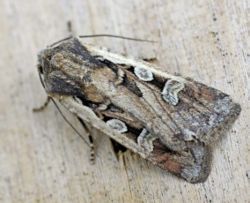You can help expand this article with text translated from the corresponding article in German. (November 2022)Click [show] for important translation instructions.
|
| Euxoa temera | |
|---|---|
 | |
| Scientific classification | |
| Kingdom: | Animalia |
| Phylum: | Arthropoda |
| Class: | Insecta |
| Order: | Lepidoptera |
| Superfamily: | Noctuoidea |
| Family: | Noctuidae |
| Genus: | Euxoa |
| Species: | E. temera |
| Binomial name | |
| Euxoa temera Hübner, 1808 | |
| Synonyms | |
| |
Euxoa temera is a moth of the family Noctuidae. It is found in Central and Southern Europe, North Africa, the Caucasus, Armenia, Central Asia, Turkey, Iraq and Iran.

The wingspan is 30–35 mm. The moth flies from October to November depending on the location.
The larvae feed on Poaceae species and other low plants.